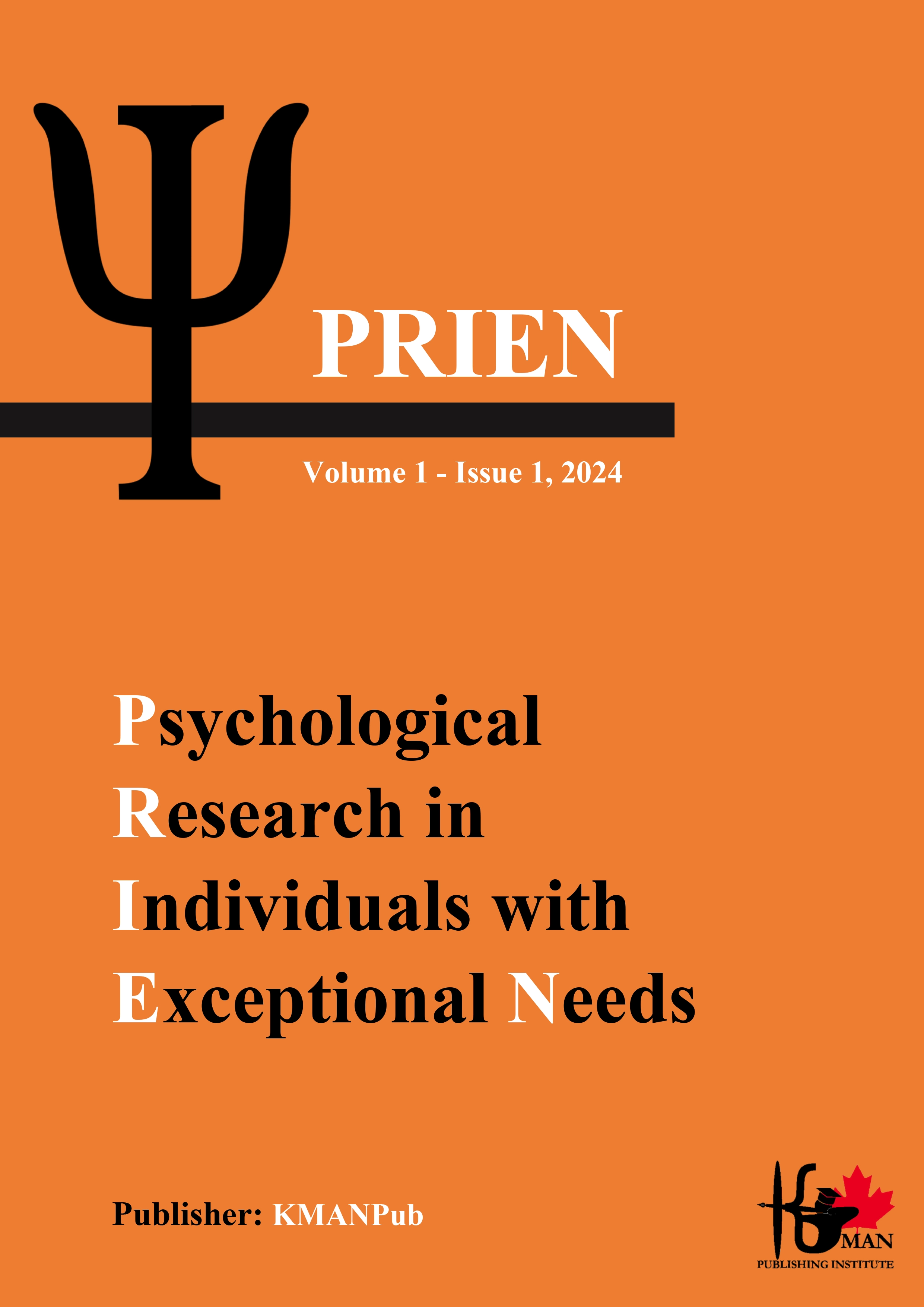Enhancing Self-Determination and Working Memory in Individuals with Visual Impairments: Efficacy of Social Skills Training
Keywords:
Self-Determination, Working Memory, Social Skills Training, Visual Impairments, Cognitive Training, Randomized Controlled Trial, RehabilitationAbstract
This study aimed to evaluate the effectiveness of social skills training on enhancing self-determination and working memory in individuals with visual impairments.
A randomized controlled trial design was used, involving 40 participants with visual impairments, randomly assigned to an intervention group (n = 20) and a control group (n = 20). The intervention group underwent ten 60-minute sessions of social skills training over four months, while the control group received no specific intervention. Self-determination was assessed using the Self-Determination Inventory: Student Report (SDI), and working memory was measured using the Working Memory Questionnaire (WMQ). Data were collected at pre-intervention, post-intervention, and a four-month follow-up. Analysis of variance (ANOVA) with repeated measures and Bonferroni post-hoc tests were conducted using SPSS version 27. Participants in the intervention group showed significant improvements in self-determination from pre-intervention (M = 45.25, SD = 6.34) to post-intervention (M = 58.43, SD = 5.27) and at the four-month follow-up (M = 55.37, SD = 5.82). Similarly, working memory scores improved from pre-intervention (M = 39.18, SD = 7.24) to post-intervention (M = 51.22, SD = 6.05) and were maintained at follow-up (M = 48.76, SD = 6.50). The ANOVA results indicated significant main effects for self-determination (F(2, 76) = 41.52, p < .001, η² = 0.53) and working memory (F(2, 76) = 38.19, p < .001, η² = 0.50), as well as significant time x group interaction effects (self-determination: F(2, 76) = 32.35, p < .001, η² = 0.46; working memory: F(2, 76) = 31.88, p < .001, η² = 0.45). The findings demonstrate that social skills training is significantly effective in enhancing self-determination and working memory in individuals with visual impairments. These improvements were sustained over a four-month follow-up period, suggesting the potential of such interventions to positively impact cognitive and social functioning in this population.
Downloads
References
Assad Zadeh, H., Majdian, V., Azadi, A., Bastami, M., & Bastami, A. (2018). Examine the Relationship between Perceived Parenting Styles with Self-Regulation School Students [Paramedical]. Iranian Journal of Nursing Research, 13(4), 9-15.http://ijnr.ir/article-1-2034-en.html
Bodaghi, M., Kamkari, K., & Saedi, S. (2023). Investigating the sensitivity coefficient of the fifth version of the Wechsler children's intelligence scale in students with attention deficit disorder. Journal of Assessment and Research in Applied Counseling (JARAC), 5(4), 9-15.https://doi.org/10.61838/kman.jarac.5.4.2
Browder, D. M., Wood, W. M., Test, D. W., Karvonen, M., & Algozzine, B. (2001). Reviewing Resources on SelfDetermination. Remedial and Special Education, 22(4), 233-244.https://doi.org/10.1177/074193250102200407
Buchanan, J. A., Johnson, E. M., Kennedy, J. L., Stypulkowski, K. A., & Jensen, N. (2019). The Effects of Cognitive Training Program for Cognitively Impaired Older Adults: A Pilot Randomized Control Trial. International Journal of Aging Research.https://doi.org/10.28933/ijoar-2019-03-0705
Caron, V., Barras, A.-C. H., Ruth, M. A. v. N., & Ruffieux, N. (2023). Teaching Social Skills to Children and Adolescents With Visual Impairments: A Systematic Review. Journal of Visual Impairment & Blindness, 117(2), 128-147.https://doi.org/10.1177/0145482x231167150
Carter, E. W., Lane, K. L., Cooney, M., Weir, K., Moss, C. K., & Machalicek, W. (2013). Self-Determination Among Transition-Age Youth With Autism or Intellectual Disability: Parent Perspectives. Research and Practice for Persons With Severe Disabilities, 38(3), 129-138.https://doi.org/10.1177/154079691303800301
Chaumba, J. (2021). Strategies for Promoting Client SelfDetermination: A Review of the Literature. Journal of Social Work Values and Ethics, 18(1), 60-71.https://doi.org/10.55521/10-018-108
Cmar, J. L., & Markoski, K. M. (2019). Promoting SelfDetermination for Students With Visual Impairments: A Review of the Literature. Journal of Visual Impairment & Blindness, 113(2), 100-113.https://doi.org/10.1177/0145482x19839796
Fernandes, V., Rodrigues, F., Jacinto, M., Teixeira, D., Cid, L., Antunes, R., Matos, R., Reigal, R. E., Mendo, A. H., Morales‐ Sánchez, V., & Monteiro, D. (2023). How Does the Level of Physical Activity Influence Eating Behavior? A SelfDetermination Theory Approach. Life, 13(2), 298.https://doi.org/10.3390/life13020298
Finn, M., & McDonald, S. (2011). Computerised Cognitive Training for Older Persons With Mild Cognitive Impairment: A Pilot Study Using a Randomised Controlled Trial Design. Brain Impairment, 12(3), 187-199.https://doi.org/10.1375/brim.12.3.187
Heled, E., Elul, N., Ptito, M., & Chebat, D.-R. (2022). Deductive Reasoning and Working Memory Skills in Individuals With Blindness. Sensors, 22(5), 2062.https://doi.org/10.3390/s22052062
Javanbakht, S., & Yousefi, Z. (2022). Investigate the Validity, Reliability and Standardization of Family Executive Function Scale among Married People. Applied Family Therapy Journal (AFTJ), 3(4), 556-584.https://doi.org/10.61838/kman.aftj.3.4.31
Kahaki, F. (2024). The Effectiveness of Social-Cognitive Competence Skills Training on Positive Affects and Executive Functions of Adolescents. Journal of Psychological Dynamics in Mood Disorders (PDMD), 3(1), 222-233.https://doi.org/10.22034/pdmd.2024.449900.1067
Kamelska, A. M., & Mazurek, K. (2015). The Assessment of the Quality of Life in Visually Impaired People With Different Level of Physical Activity. Physical Culture and Sport Studies and Research, 67(1), 31-41.https://doi.org/10.1515/pcssr-2015-0001
Manitsa, I., & Δόικου, Μ. (2020). Social Support for Students With Visual Impairments in Educational Institutions: An Integrative Literature Review. British Journal of Visual Impairment, 40(1), 29-47.https://doi.org/10.1177/0264619620941885
Porflitt, F., & Rosas-Díaz, R. R. (2019). Behind the Scene: Cognitive Benefits of Playing a Musical Instrument. Executive Functions, Processing Speed, Fluid Intelligence and Divided Attention / Detrás De La Escena: Beneficios Cognitivos De Tocar Un Instrumento Musical. Funciones Ejecutivas, Velocidad De Procesamiento, Inteligencia Fluida Y Atención Dividida. Studies in Psychology, 40(2), 464-490.https://doi.org/10.1080/02109395.2019.1601474
Pourjaberi, B., Shirkavand, N., & Ashoori, J. (2023). The Effectiveness of Cognitive Rehabilitation Training on Prospective Memory and Cognitive Flexibility in Individuals with Depression. International Journal of Education and Cognitive Sciences, 4(3), 45-53.https://doi.org/10.61838/kman.ijecs.4.3.5
Salemi, M. H., Foroozandeh, E., & Asadi-Gharneh, H. A. (2023). Effectiveness of Horticultural Therapy on Improving Memory, Alexithymia, and Severity of Symptoms in Patients with Persistent Depressive Disorder. KMAN Counseling & Psychology Nexus, 1(1), 1-10.https://doi.org/10.61838/kman.psychnexus.1.1.1
Sánchez, M. M., Melo, A. C., Blanco, L. S., & García, A. F. (2022). Chatbot, as Educational and Inclusive Tool for People With Intellectual Disabilities. Sustainability, 14(3), 1520.https://doi.org/10.3390/su14031520
Tanaka, H., Negoro, H., Iwasaka, H., & Nakamura, S. (2017). Embodied Conversational Agents for Multimodal Automated Social Skills Training in People With Autism Spectrum Disorders. PLoS One, 12(8), e0182151.https://doi.org/10.1371/journal.pone.0182151
Thoma, C. A., Williams, J., & Davis, N. (2005). Teaching SelfDetermination to Students With Disabilities. Career Development for Exceptional Individuals, 28(2), 104-115.https://doi.org/10.1177/08857288050280020101
Xie, X. (2023). The Effects of Auditory Working Memory Task on Situation Awareness in Complex Dynamic Environments: An Eye-Movement Study. Human Factors the Journal of the Human Factors and Ergonomics Society, 66(7), 1844-1859.https://doi.org/10.1177/00187208231191389

Downloads
Additional Files
Published
Issue
Section
License

This work is licensed under a Creative Commons Attribution-NonCommercial 4.0 International License.















